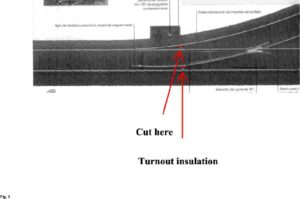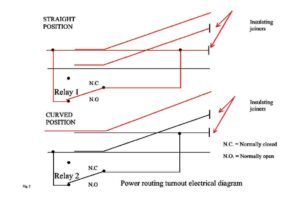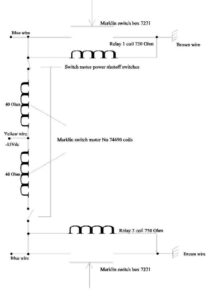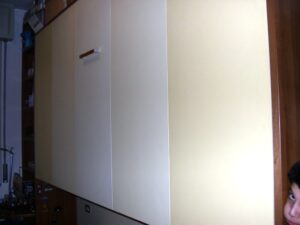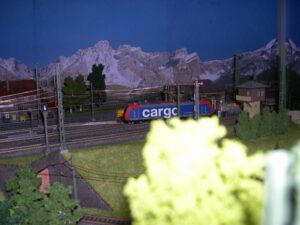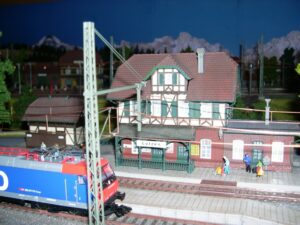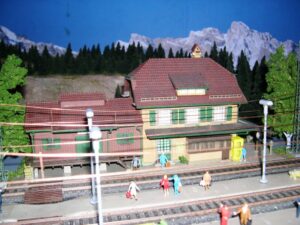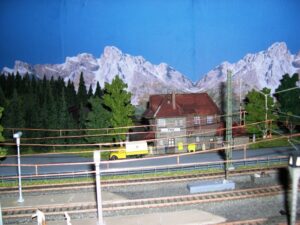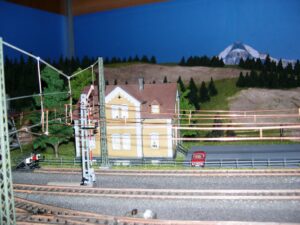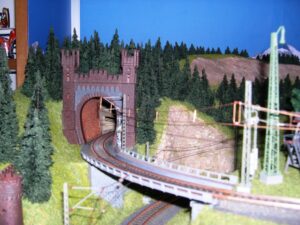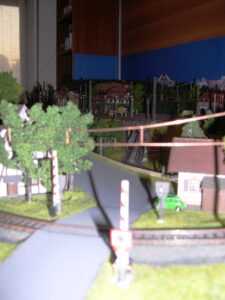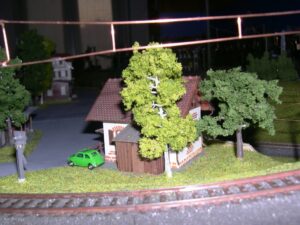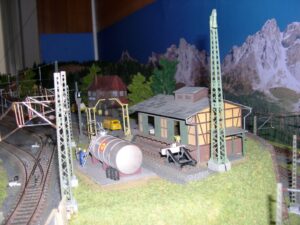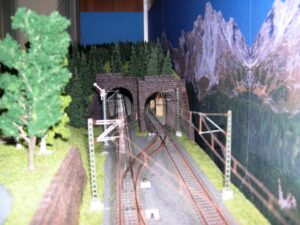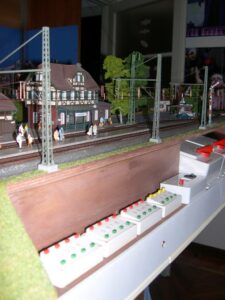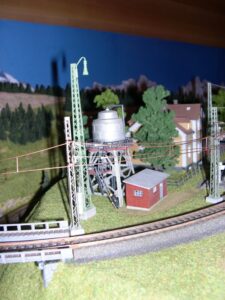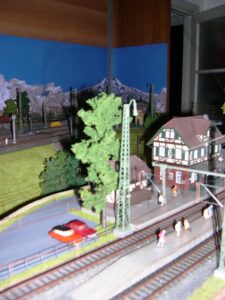Ho costruito un plastico universale per poter far circolare locomotive DC e locomotive Marklin sugli stessi binari senza modificare in alcun modo le locomotive stesse . La ragione di questa mia scelta e’ che ho una buona esperienza di sistemi in DC ( 25 anni ) e per fare qualcosa di nuovo volevo entrare nel fantastico mondo di Marklin, ma volevo anche continuare ad usare le mie loco in DC. Cosi’ ho deciso ho deciso di costruire un plastico universale.
Generalita’
– compatibilita’ sistema 2 rotaie e 3 rotaie sullo stesso plastico
– nessuna modifica su locomotive e rotabili
– utilizzo dei medesimi alimentatori (opzionale)
– semplici modifiche sul sistema di binari
Si noti che impossibile far funzionare il sistema in AC e DC contemporaneamente.
Scelte di sistema
Dopo aver letto lo speciale di Marklin Magazine dedicato al binario C ( numero di catalogo Marklin 188987 ) , nel quale l’autore Markus T.Nickl spiega tutti i “trucchi“ del binario C, ho deciso che il binario C era quello adatto per il mio scopo.
Le ragioni di questa scelta sono le seguenti :
– Binari con massicciata. Altezza del profilo della rotaia 2,3 mm. (codice 90). E’ un buon compromesso tra realismo e funzionamento.
– Facile isolamento dei binari. Questo e’ mandatorio per il funzionamento in DC.I binari sono progettati per essere isolati per gli automatismi in AC ;ci sono 2 ponticelli per ogni sezione di binario che possono essere tagliati utilizzando utilizzando un tronchesino. Rimando al Marklin Magazine C Spezial per questo argomento.
– Cuori in metallo. Questo e’ ottimo per il funzionamento in continua e per il funzionamento in digitale sia DC che AC. A questo punto ho acquistato un deviatoio per studiare la soluzione piu’ semplice.
Come isolare e polarizzare i cuori dei deviatoi Marklin C per il funzionamento in DC
Dopo alcuni esperimenti ho trovato una soluzione relativamente semplice. Per avere prestazioni affidabili nel tempo sono necessarie modifiche sia meccaniche che elettriche. Per non distruggere i meravigliosi deviatoi Marklin le modifiche meccaniche sono molto semplici pertanto e’ preferibile lavorare sui collegamenti elettrici.
Prima di tutto e’ necessario tagliare le due connessioni metalliche tra gli aghi e le rotaie esterne; per fare questo ho utilizzato il Dremel equipaggiato con un disco da taglio molto sottile .Posso affermare che i tagli sono pressoche’ invisibili e che la robustezza meccanica e’ la medesima di prima. A questo punto ho ottenuto un cosiddetto “power routing turnout“ assolutamente uguale da un punto di vista elettrico ad un deviatoio Peco Electrofrog (vedere catalogo Peco per questo argomento). Ora e ‘ necessario polarizzare il cuore secondo la posizione degli aghi (bisogna cambiare la polarita’ del cuore secondo la posizione del deviatoio).
Di solito questa e’ un’ operazione molto semplice se il motore del deviatoio e’ equipaggiato con contatti ausiliari, ma sfortunatamente i motori Marklin non hanno questa opzione. Cosi’ per polarizzare i cuori ho connesso le bobine di due rele’ monostabili tra i fili blu ed il filo marrone per avere un perfetto sincronismo tra le bobine dei relè stessi e le bobine del motore. Questo e’ possibile perche’ i motori Marklin sono equipaggiati con interruttori di fine corsa. Si connetta il cuore al pin centrale del rele’ e l’alimentazione in continua al pin normalmente aperto secondo la polarità delle rotaie esterne. In caso di corto circuito si inverta semplicemente la polarita’ dell’ alimentazione in continua. Ora tutto funzionerà perfettamente.
Si noti che:
– i motori degli scambi vanno alimentati in continua a 15V stabilizzati, poiche’ i rele a bassa tensione sono progettati per funzionamento in DC
– la resistenza della bobina del rele deve essere 700-800 Ohm. La reperibilita’ di questi rele’ e’ molto facile nei negozi di elettronica e il costo e’ molto modesto (3€ circa)
– nel mio plastico io ho usato solo deviatoi semplici, cosi’ non ho idea di come fare su scambi inglesi e a tre vie, ma penso che si possa fare perche’ sembrerebbero gia’ isolati
In ogni caso suggerisco di consultare questo libro per tutti i cablaggi in DC:
Easy model railroad wiring – Andy Sperandeo – Kalmbach Editions
Utilizzo del medesimo sistema di alimentazione per AC e DC
Il peggior nemico di ogni fermodellista e’ lo spazio ; infatti non avevo posto a sufficienza per altri due alimentatori DC nel mio plastico. La soluzione adottata e’ stata quella di utilizzare un rele’ elettronico passo passo per sfruttare l’impulso a 24 V dei trasformatori Marklin per invertire la polarita’ e raddrizzare la tensione alternata variabile.Roco e Hag hanno questi dispositivi gia’ pronti all’uso ; sono progettati per trasformare le loco in continua per il sistema Marklin. Ho acquistato due Hag (25 € ciascuno) e li ho semplicemente connessi tra gli alimentatori Marklin e il binario quando faccio funzionare il plastico in DC: il tutto funziona perfettamente.
Si noti che detti dispositivi sono progettati per alimentare direttamente i motori in continua, pertanto per avere una protezione efficiente contro i sovraccarichi ho usato il dispositivo di protezione Marklin 74046 in serie tra il rele’ Hag e i binari.
Conclusioni
Ho fatto moltissimi test utilizzando vecchie loco Fleischmann e Hamo poiche’ sono equipaggiate con ruote a bordini alti e sono molto soddisfatto. Funzionano molto bene anche sugli scambi! Cosi’ ora uso come voglio sia loco DC che AC in modo ottimale.
English version:
I am building an universal layout in order to run DC locos and Marklin locos on the same track system without modifying the locos in any way.
The reason is that I am an experienced modeller in DC system (25 years) and now to something new I want to enter the fantastic Marklin world but I also want to use again my moreless 100 DC locos. So I have decided to build an universal layout.
Feature list
– 2 rail system and 3 rail system on the same layout
– no modifications of locos and rolling stock
– use of the same power supply system (optional)
– very simple modifications on the track system
It must be noticed that it’s impossible to operate AC and DC at the same time!
System choices
After reading Marklin Magazine C Gleis Spezial book ( Marklin catalog No 188987) in which the author Markus T. Nickl explains very well all the tips of the C track.
I decided that this was the right track system for my purpose.
The rasons of this choice are the following :
– Ready ballasted track
– Profile height 2,3 mm (code 90 ) . It’s a good compromise between realism and operation
– Easy insulation of the rails . This is a must for DC operation.
Tracks are designed to be insulated for AC automatisms; there are two jumpers for each track section that can be cut using nippers. Refer to Marklin Magazine C Gleis Spezial for this matter.
– Metal frogs. This is very good for DC operation and digital operation both for DC an AC. At this point I had the problem to insulate the turnouts and feed the frogs for DC operation; so I bought a turnout to study the easiest solution.
How to insulate and feed Marklin C turnouts for DC operation
After some experiments I found a quite simple solution.
To have always good performance mechnical and electrical modifications are required.
In order not to destroy the marvellous Maklin turnouts mechnical modifications are very simple and so it’s better to work on electrical wiring.
First of all it’s necessary to cut the two metal connections between the points of the turnout and the outer rails; to do this I use Dremel tool equipped with a very thin disc saw.
I can assure that the cuts are moreless invisible and that the mechnical integrity is the same as before. At this point you have obtained a so called “power routing turnout“ absolutely the same from the electrical point of view, as a Peco electrofrog turnout (see Peco catalog for this point). Now it’s necessary to feed the frog according the position of the turnout (you have to change the polarity of the frog when you change the position ). Generally it’s a very simple operation if the switch machine is equipped with auxiliary contacts, but unfortunately Marklin switch machine has no this option. So to feed frogs I have connected the coils of two monostable relays between blue wires and brown wire in order to have a perfect syncronisation with the coils of the motor and the coils of the relays.
You can do this because Marklin switch machines are equipped with power shutoff switches.
Connect the frog to the center pin of the relays and the DC supply to the “ normaly open “pins of the relays according the polarity of the outer rails .In case of short simply reverse the polarity of DC feed. Now everything will work in the right way .
It must be noticed that:
– Turnout motors must be supplied with 15V DC because the low voltage relays are designed for DC operation.
– DC coil resistance of the relays should be 700- 800 Ohms.
It’s very easy to find this kind of relay in every electronic shop and the price is not expansive (I have paid them 2.5 Euros each).
– In my layout I use only normal turnouts, so I don’t know exactly how to operate on double slips and 3 way turnouts but I think it shold be very simple because these turnouts seem to be already insulated.
In any case I suggest to refer to this book for all tips concerning DC wiring: Andy Sperandeo – Easy model railroad wiring – Kalmbach Editions.
Using the same power supply system for DC and AC operation.
The worst enemy of every model railroader is the the space; infact I had no sufficient space to install other two DC trasformers in my layout.
The solution was to use an electonic step relay in order to use the 24 VAC pulse supplied by Marklin trasformers to reverse the polarity and to rectify the AC variable voltage.
Hag and Roco has these devices ready to run; they are designed to transform DC loco for Marklin system. I have purchased two devices by Hag (25 Euros each) and I have simply connected them between Marklin trasformers and the rails when I use DC locos: everything works in the right way.
It must be noted that these devices are designed to operate directly on a DC motor so to have a good overload protection I use the Marklin device No.74046 in series between Hag reverse unit and the rails.
Conclusions
Till now I have made some test using old Fleishmann and Hamo locos because they are equipped with high flange wheels; I am very satisfied: they run very well on the turouts!
So now when I want I use DC and AC locos in the best way.


